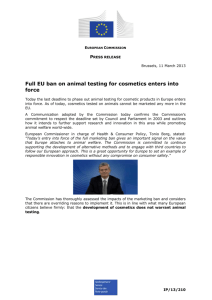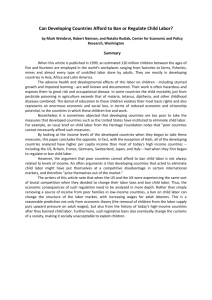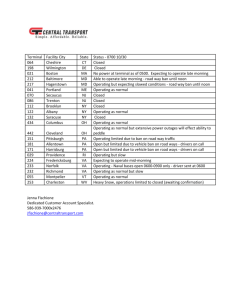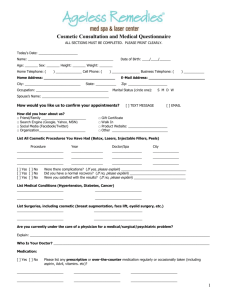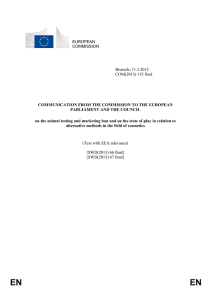Blanket Ban on Animal Testing on Cosmetics Enters into Force
advertisement
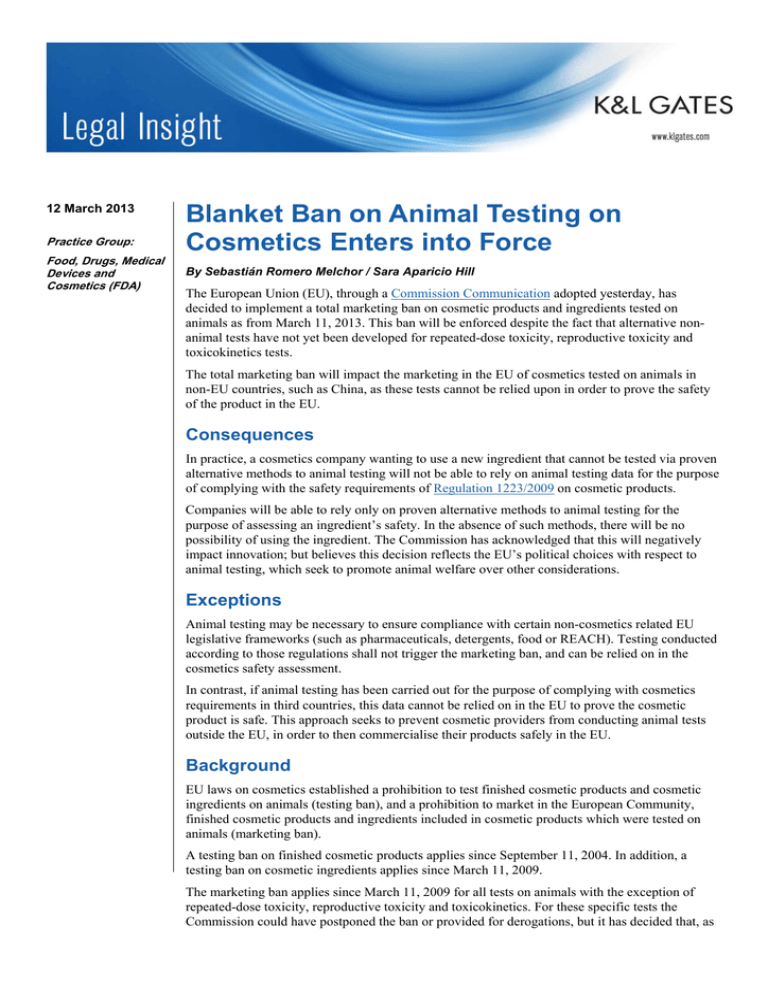
12 March 2013 Practice Group: Food, Drugs, Medical Devices and Cosmetics (FDA) Blanket Ban on Animal Testing on Cosmetics Enters into Force By Sebastián Romero Melchor / Sara Aparicio Hill The European Union (EU), through a Commission Communication adopted yesterday, has decided to implement a total marketing ban on cosmetic products and ingredients tested on animals as from March 11, 2013. This ban will be enforced despite the fact that alternative nonanimal tests have not yet been developed for repeated-dose toxicity, reproductive toxicity and toxicokinetics tests. The total marketing ban will impact the marketing in the EU of cosmetics tested on animals in non-EU countries, such as China, as these tests cannot be relied upon in order to prove the safety of the product in the EU. Consequences In practice, a cosmetics company wanting to use a new ingredient that cannot be tested via proven alternative methods to animal testing will not be able to rely on animal testing data for the purpose of complying with the safety requirements of Regulation 1223/2009 on cosmetic products. Companies will be able to rely only on proven alternative methods to animal testing for the purpose of assessing an ingredient’s safety. In the absence of such methods, there will be no possibility of using the ingredient. The Commission has acknowledged that this will negatively impact innovation; but believes this decision reflects the EU’s political choices with respect to animal testing, which seek to promote animal welfare over other considerations. Exceptions Animal testing may be necessary to ensure compliance with certain non-cosmetics related EU legislative frameworks (such as pharmaceuticals, detergents, food or REACH). Testing conducted according to those regulations shall not trigger the marketing ban, and can be relied on in the cosmetics safety assessment. In contrast, if animal testing has been carried out for the purpose of complying with cosmetics requirements in third countries, this data cannot be relied on in the EU to prove the cosmetic product is safe. This approach seeks to prevent cosmetic providers from conducting animal tests outside the EU, in order to then commercialise their products safely in the EU. Background EU laws on cosmetics established a prohibition to test finished cosmetic products and cosmetic ingredients on animals (testing ban), and a prohibition to market in the European Community, finished cosmetic products and ingredients included in cosmetic products which were tested on animals (marketing ban). A testing ban on finished cosmetic products applies since September 11, 2004. In addition, a testing ban on cosmetic ingredients applies since March 11, 2009. The marketing ban applies since March 11, 2009 for all tests on animals with the exception of repeated-dose toxicity, reproductive toxicity and toxicokinetics. For these specific tests the Commission could have postponed the ban or provided for derogations, but it has decided that, as Blanket ban on animal testing on cosmetics enters into force from March 11, 2013, repeated-dose toxicity, reproductive toxicity and toxicokinetics tests may no longer be performed. In any case, and regardless of the EU’s current position, the ultimate interpretation of the meaning of the marketing ban on animal testing will correspond to the Court of Justice of the European Union. Authors: Sebastián Romero Melchor sebastian.romeromelchor@klgates.com +32.(0)2.336.1906 Sara Aparicio Hill sara.apariciohill@klgates.com +32.(0)2.336.1928 Anchorage Austin Beijing Berlin Boston Brisbane Brussels Charleston Charlotte Chicago Dallas Doha Dubai Fort Worth Frankfurt Harrisburg Hong Kong Houston London Los Angeles Melbourne Miami Milan Moscow Newark New York Orange County Palo Alto Paris Perth Pittsburgh Portland Raleigh Research Triangle Park San Diego San Francisco São Paulo Seattle Seoul Shanghai Singapore Spokane Sydney Taipei Tokyo Warsaw Washington, D.C. K&L Gates practices out of 47 fully integrated offices located in the United States, Asia, Australia, Europe, the Middle East and South America and represents leading global corporations, growth and middle-market companies, capital markets participants and entrepreneurs in every major industry group as well as public sector entities, educational institutions, philanthropic organizations and individuals. For more information about K&L Gates or its locations, practices and registrations, visit www.klgates.com. This publication is for informational purposes and does not contain or convey legal advice. The information herein should not be used or relied upon in regard to any particular facts or circumstances without first consulting a lawyer. ©2013 K&L Gates LLP. All Rights Reserved. 2
